Lately I’ve been having a lot of conversations around investment terms with searchers, as well as investors.
About 15 years ago, I interned at a search fund. And, over the last few years, I’ve started to invest in the asset class going direct as well as through funds of search funds.
Investing in search funds is a great way to scratch my entrepreneurial itch, extremely rewarding when a searcher finds success, and can be economically rewarding too.
This post is my attempt to share thoughts on self funded search economics in an effort to contribute to the search fund community, get feedback on my thinking from a wider audience, and of course meet more people who are doing searches/investing and may want to collaborate (please feel free to reach out!).
You can watch a video of me explaining this model here, and download the excel here:

Enterprise Value
The standard finance equation is enterprise value = debt + stock – cash. Enterprise value is how much the company itself is worth. Many times people confuse it with how much the stock is worth and find the “minus cash” part of this really confusing.
So, you can rearrange this equation to make it stock = enterprise value – debt + cash. Make more sense now?
Enterprise value is just how much you’re willing to pay for the company (future cash flows, intellectual property, etc), not the balance sheet (debt and cash).
Most investors and searchers think about the EBITDA multiple of a company on an enterprise value basis because they’ll be buying it on a cash free, debt free basis. It becomes second nature to think about EBITDA multiples and know where a given business should fall given scale, industry, etc.
However, I believe this second nature way of thinking of things can be a massive disadvantage to investors given the way EV and multiples are talked about in our community currently.
Sources of capital, the typical way to calculate enterprise value for self funded searchers
If you’ve ever looked at or put together a teaser for a self funded search deal, you will notice that the deal value is equal to the sum of the sources of capital minus deal fees and cash to the balance sheet.
As a simple example, if there is $4 mm of debt to fund the deal, $1 mm of equity, and $200k of deal fees, the enterprise value = $4 mm + $1 mm – 200k = $4.8 mm.
We’ll use slightly more complex numbers in our example: If a searcher is taking a $3.2 mm SBA loan, $850k seller note, putting in $120k themselves, getting $350k of equity from the seller, a $500k earnout, and $1.2 mm of equity financing minus $350k to the balance sheet and $250k of deal fees, then the enterprise value will be $5.62 mm.
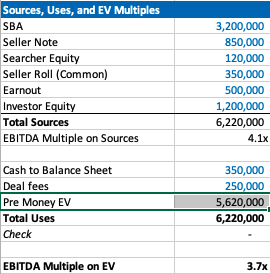
Our example company has $1.5 mm of EBITDA, so the EBITDA multiple is 3.7x. This is a pretty attractive acquisition multiple for a business that meets traditional search criteria (recurring revenues, fragmented competition, high gross margins, low customer concentration, etc).
If you’re seeing a search fund deal for the first time, the headline of “we’re buying a decent company for 3.7x, and replacing a tired owner with a hungry operator” is pretty exciting!
However, if you’re an investor, there is some nuance to this enterprise value number and the true EBITDA multiple you are investing in.
The trick with self funded enterprise value
The security that most self funded search investors get in a deal is participating preferred stock with a paid in kind dividend. This means when there’s an exit, you get your money back before any other equity holder, then get a certain percent of the business, and whatever dividend you’ve been owed in the interim accrues to your principle.
It’s a really favorable security for the investor, and one that is basically impossible to get in VC where straight preferred stock is much more common (no pun intended).
The key terms are what percent of common equity does this security convert into after the originally principal is paid back, and what is the dividend.
The share of common equity the investor group will get typically ranges from 10-50% of the total common stock. The dividend rate is usually 3-15%. The average I’m seeing now is around 30% and 10% for common and dividends respectively.
The strange this about the enterprise value quoted to investors in a teaser/CIM is that it doesn’t change as the percent of common changes, even though this has large implications for how much the common equity is worth and the value investors receive.
For example, I may get a teaser where the sources of investment – cash to balance sheet – deal fees = $3.7 mm for a $1 mm EBITDA company, which would imply a 3.7X EBITDA multiple. Let’s say the searcher is offering investors 30% of the common and a 10% dividend.
Let’s now say that the searcher is having a tough time raising capital and changes their terms to 35% of common and a 12% dividend. Does the effective enterprise value change for investors? I would argue yes, but I would be surprised to see it changed in the CIM/teaser.
This isn’t a knock on searchers or the search fund community. It’s just kind of how things are done, and I think this is mostly because it’s really hard to think about how the enterprise value has changed in this scenario.
However, the natural way of using EBITDA multiples to think about value for a business that is so common in PE/SMB can be extremely misleading for investors here. You may be thinking 3.7X for this type of business is a great deal! But, what if the security you’re buying gets 5% of the common?
If you’re in our world, you may counter this point by saying most searchers will also supply a projected IRR for investors in their CIM. However, IRR is extremely sensitive to growth rate, margin expansion, and terminal value. While the attractiveness of the security will be reflected, it can be greatly overshadowed by lofty expectations.
To get more clarity and have a slightly different mental model on the effective price investors are paying for this business, let’s go back to basics. Enterprise value should be debt + preferred stock + common stock – cash.
We know the values of each of these numbers, except the common. So, the main question here becomes: how much is the common equity worth?
Calculating value of common equity for self funded search funds
Equity value for most search fund deals = preferred equity from investors + the common equity set aside for the searcher and sometimes also advisors, board, seller.
We know that the preferred equity is investing a certain amount for a certain amount of common equity. The rub is that they are also getting a preference that they can take out before any common equity gets proceeds, and they are getting a dividend.
So, the exercise of valuing the common equity comes down to valuing the preference and dividend.
In my mind, there are three approaches:
- The discount rate method where you take the cash flows you’ll get in the future from the pref/dividends and discount them back at the discount rate of your choice. I am using 30% in my model which I believe accurately compensates investors for the risks they are taking in a small, highly leveraged investment run by an unproven operator. If you believe in efficient markets, this number also fits as it mirrors the historical equity returns as reported by the Stanford report, with a slight discount given this asset class has clearly generated excess returns relative to other assets on a risk adjusted basis, hence interest in these opportunities from an expanding universe of investors.
- The second method is to calculate how much money you’d get from your preference and dividends, taking into account that per the Stanford study around 75% of search funds will be able to pay these sums, and then discount these cash flows back at a rate more in line with public equities (7% in my model). This yields a much higher value to the preference/dividend combo, and therefore lowers the implied value of the common equity.
- The last method is to just say nope, there is no value to the preference and dividend. I need them and require them as an investor, but they are a deal breaker for me if they aren’t there, and therefore they don’t exist in my math. This of course makes no logical sense (you need them, but they also have no value?), but I’ve left it in as I think many investors probably actually think this way and it creates a nice upper bound on the enterprise value. Side note, as with obstinate sellers, jerk investors are usually best avoided.
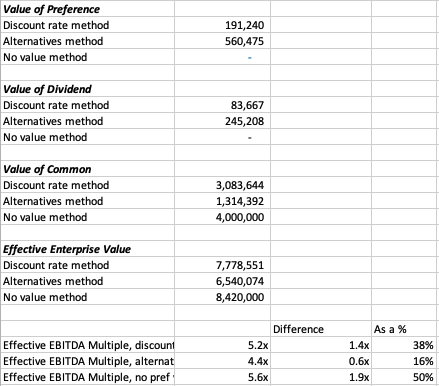
In our example, you can see a breakdown of the preference value, dividend value, and therefore common value and enterprise value for this deal.
In each case, the effective EBITDA multiple moves from 3.7x to something much higher (see the last 3 lines).
There are some simplifying assumptions in the model (no accruing dividend, all paid in last year), and some weird stuff that can happen (if you make the hold time long and the dividend greater than the 7% equity discount rate, the value of the dividend can get really big).
These flaws aside, I think this creates a nice framework to think through what the common is actually worth at close, and therefore what enterprise value investors will be paying in actuality.
It’s worth noting that the whole point of this is to benchmark the value you’re getting relative to market transactions in order to understand where you want to deploy your capital.
This creates a method to translate cash flow or EBITDA multiples of other opportunities on an apples to apples basis (if only there were a magical way to translate the risk associated with each as well!).
Another note, we could calculate the value of the common to be what this asset would trade at market today in a well run auction process minus any obligations (debt, preference, seller financing). However, I think that understates the option value inherent in this equity, a value that is only realized when a new manager takes over with more energy and know how.
There is a finance nerd rational for this. If you plot the value of equity in a leveraged company on a chart, it mirrors the payout of a call option. In both cases, the value of the security increases at a certain inflection point: when the value of equity rises above the strike price in an option, and when the enterprise value of a company rises above the debt level in a levered company.
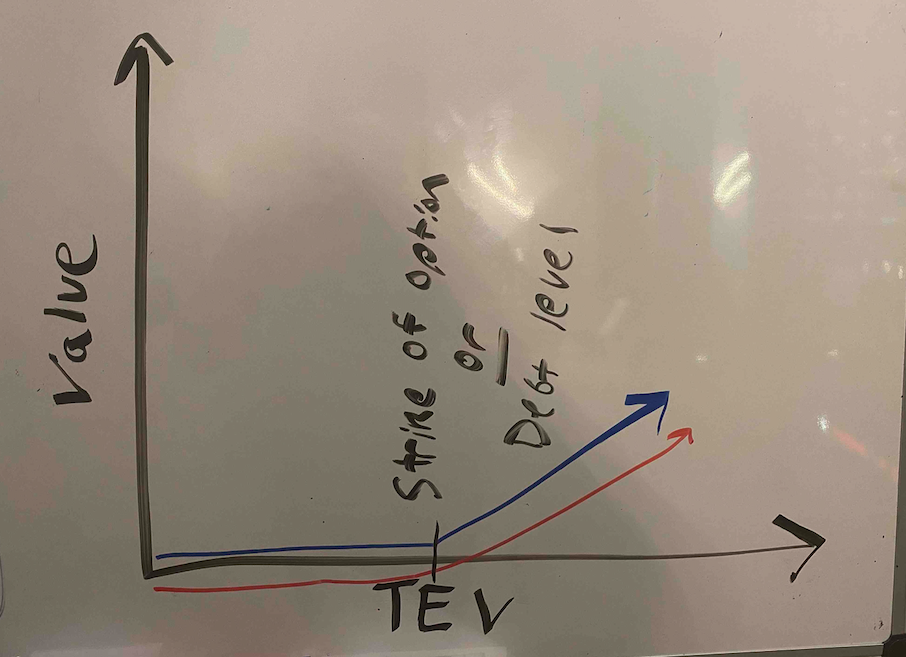
The common equity of a highly levered company can therefore be valued by a similar methodology as the call option: Black Scholes. If you remember back to finance class, increasing volatility will increase the value of an option.
In the search fund case, we’ve (hopefully) increased the (upside) volatility and therefore create more value than simply selling the company today.
A few more thoughts on investor economics
There are a few other ways to think about the economics you get as an investor to best understand if this is the deal for you.
First, you may want to think about how much your investment will be worth day 1. The key lever in this model is what discount this company is being bought for relative to fair market value. For example, the searcher may have proprietary sourced a great company and is buying it for 25% below what it would trade at in a brokered auction.
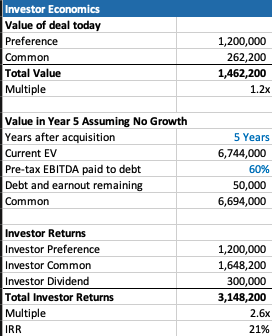
This is very much a “margin of safety” philosophy on things. Same with the calculation on how much you’ll receive in year 5 (after QSBS hits) assuming no growth in the business.
The only problem with each of these calculations is that they never play out in practice. Most companies don’t just stay the same, you’re either in a rising tide or you’re in trouble. And, you’re almost never going to sell in year 1, and definitely not for a slight premium to what it was bought for.
However, if your investment is worth 30% higher day one, and you can make a 20% IRR assuming nothing too crazy happens either way in the business, that’s not a bad place to start. Add in a strong searcher, decent market, some luck, and you’re off to the races.
Thoughts on searcher economics
A lot of this post has considered things from the investor perspective as my main quandary was related to how to create an EBITDA multiple that made sense for investors.
However, the point of this post is not to say searchers are misrepresenting or being unrealistic with their terms. In fact, I think it’s quite logical that self funded searchers capture the massive economic value that they do.
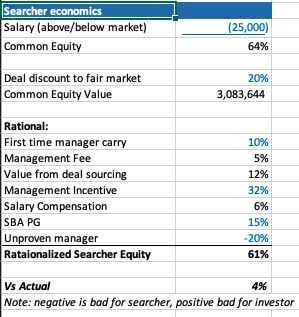
There are many reasons why self funded searchers deserve the lion share of the common equity.
First, they are providing a nice service of giving investors a positive expected value home to park their money with much lower correlation to the market than other asset classes ($1 mm EBITDA companies don’t see lots of multiple contraction/expansion throughout cycles).
Most money managers that fit that criteria are taking a 2/20, of course they also usually have a track record. So, I’ve used a 10% carry in my model, but stuck to 2% annual management fee.
The searcher spent a lot of time, and probably money, finding this company. That’s a lot of value, especially if it’s a below market price. They should be able to capture a lot of the value in finding a below market deal.
The searcher may be taking a below market salary, and needs to get comped like any CEO, with stock options. In my example model I have $1 mm of stock vesting over the hold period, as well as extra comp for taking a below market salary.
Searchers are also usually putting their financial standing at risk by taking a personal guarantee on the bank/SBA loan. This is really tough to put a number on, as is the last line in my framework where searchers are dinged for lack of experience. Like any good model, you need a few lines that you can fudge to make the math work 🙂
What you do think?
I’m shocked that I wrote all this. I was going to type a few paragraphs and a quick excel. However, putting this to paper has been a great exercise for me to sharpen my thinking.
Now I’d like you to help me further. Where do you think this should be changed in this framework? How do you think about things from the investor and/or searcher side?
Feel free to shoot me a note if you have thoughts (even just to tell me I’m being way too academic with this, which I actually agree with).
Lastly, a post like this is really a trap I’m putting on the internet to catch any like minded people in so that we can figure out ways to collaborate now or in the future. So, at the very least, connect with me on LinkedIn 🙂
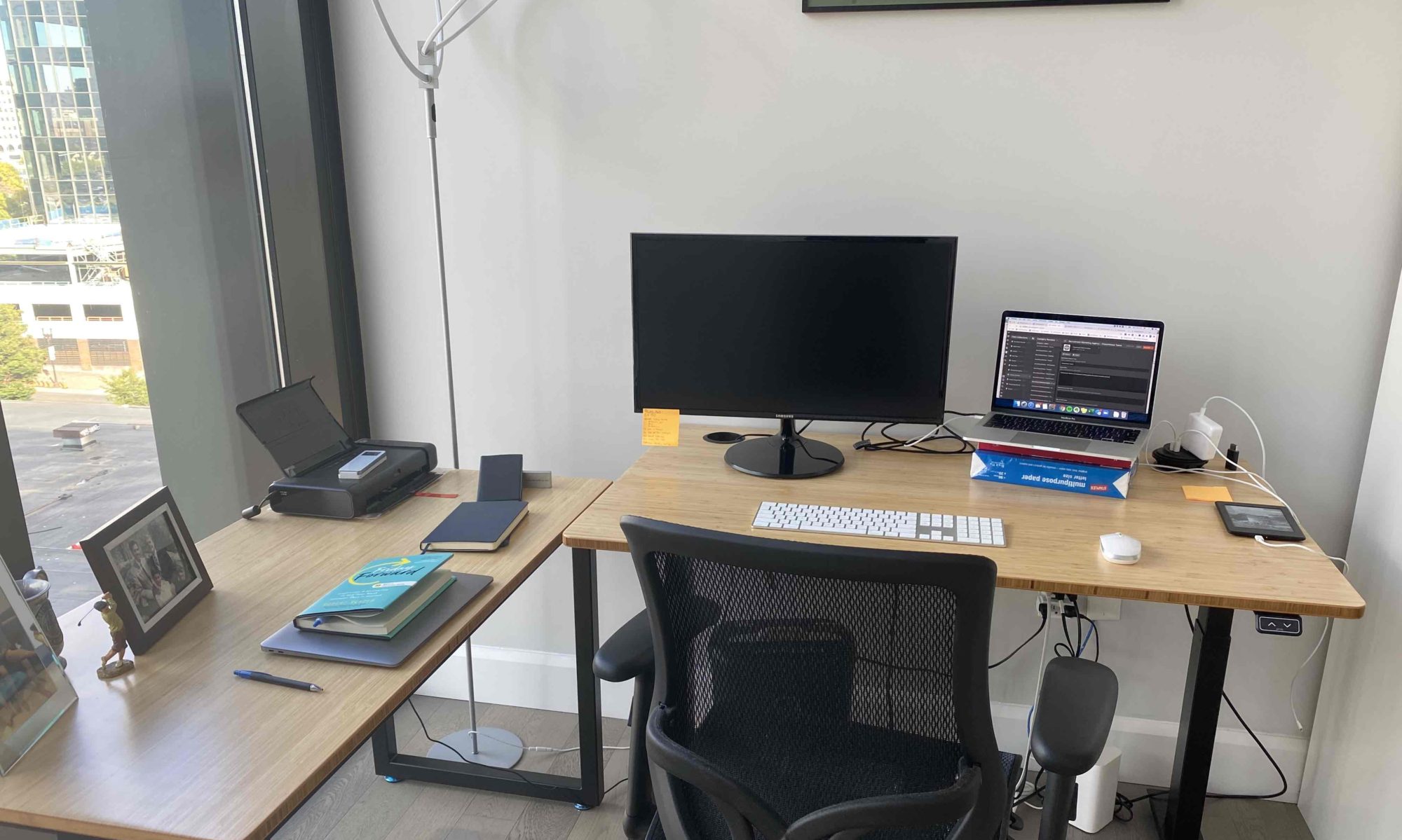
It’s difficult to find knowledgeable people in this particular
topic, but you seem like you know what you’re talking about!
Thanks
This post will assist the internet people for building up nnew
webpawge or even a weblog from start to end.
site
It’s an awesome post for all the internet users; they will obtain benefit from
it I am sure.
It’s a shame you don’t have a donate button! I’d certainly donate to this
superb blog! I suppose for now i’ll settle for book-marking and adding your RSS feed to my Google account.
I look forward to new updates and will share this website
with my Facebook group. Chat soon!
You have very nice post and pictures, please have a look at our photo tours in the
temples of Angkor
podomatic.com
Today, I went to the beachfront with my children. I found a sea shell and gave
it to my 4 year old daughter and said “You can hear the ocean if you put this to your ear.” She put the shell to her ear and screamed.
There was a hermit crab inside and it pinched her ear. She never
wants to go back! LoL I know this is entirely off topic but
I had to tell someone!
Do you have a spam problem on this site; I also am a blogger, and I
was wanting to know your situation; many of us have developed some nice procedures and we
are looking to exchange strategies with other folks, be sure to shoot me
an email if interested.
You have very nice post and pictures, please have a look at our photo tours
in the temples of Angkor
merlot.org
Glad to be one of the visitors on this awe inspiring site : D.
all the time i used to read smaller posts which also clear their motive,
and that is also happening with this post which
I am reading here.
Does your website have a contact page? I’m having a tough time locating it but,
I’d like to shoot you an e-mail. I’ve got some ideas for your blog you might
be interested in hearing. Either way, great blog and I look
forward to seeing it improve over time.
I’ve been exploring for a little bit for any high-quality articles or weblog posts on this kind of space
. Exploring in Yahoo I finally stumbled upon this website.
Reading this information So i’m glad to exhibit that I’ve an incredibly good uncanny feeling I discovered just what I
needed. I so much indubitably will make sure to don?t fail to remember this website and provides it a glance regularly.
This design is wicked! You obviously know how to keep
a reader entertained. Between your wit and your videos, I
was almost moved to start my own blog (well, almost…HaHa!) Great job.
I really loved what you had to say, and more than that,
how you presented it. Too cool!
If some one needs expert view on the topic of blogging afterward i propose him/her to pay a
quick visit this website, Keep up the fastidious
work.
It is really a great and helpful piece of info.
I am satisfied that you shared this useful info with us.
Please keep us up to date like this. Thank you for sharing.
hello there and thank you for your information – I have certainly picked up anything new from
right here. I did however expertise several technical points using this web site, as I experienced to reload the web site many times previous to
I could get it to load correctly. I had been wondering if your web host is
OK? Not that I’m complaining, but sluggish loading instances times will
often affect your placement in google and could damage your quality score if advertising and marketing with Adwords.
Anyway I’m adding this RSS to my e-mail and can look out for a lot more of your respective intriguing content.
Ensure that you update this again very soon.
Keep on writing, great job!
Hmm is anyone else encountering problems with the images on this
blog loading? I’m trying to figure out if its a problem on my end or if it’s the blog.
Any suggestions would be greatly appreciated.
Here is my webpage :: asap Cash home buyers
It’s genuinely very difficult in this full of activity life to listen news on TV, so I
only use web for that reason, and take the newest news.
I’m really enjoying the theme/design of your site.
Do you ever run into any internet browser compatibility issues?
A handful of my blog visitors have complained about my website
not operating correctly in Explorer but looks great in Safari.
Do you have any solutions to help fix this issue?
Hi there, just wanted to tell you, I loved this article.
It was practical. Keep on posting!
Hi there, You have done aan excellent job. I’ll certainly digg it and personally suggest to my friends.
I am sure they will be benefited from this web site.
My webpage: reallifecam, real life cam, reallife cam, reallifecam, voyeur-house
This design is wicked! You definitely know how to keep a reader entertained.
Between your wit and your videos, I was almost moved
to start my own blog (well, almost…HaHa!) Fantastic job.
I really enjoyed what you had to say, and more than that,
how you presented it. Too cool!
Hi everyone, it’s my first visit at this website, and
piece of writing is actually fruitful in favor of me, keep up posting these content.
I’d like to find out more? I’d care to find out some additional information.
I am sure this post has touched all the internet visitors, its really really nice piece
of writing on building up new webpage.
May I simply just say what a comfort to uncover an individual who
truly understands what they are talking about on the net.
You actually realize how to bring an issue to light and make it
important. A lot more people really need to check this out and understand
this side of the story. It’s surprising you aren’t more popular given that you definitely have the gift.
fantastic issues altogether, you just received a new reader.
What could you suggest in regards to your put up
that you simply made a few days in the past? Any certain?
Fantastic beat ! I wish to apprentice while you amend your
site, how can i subscribe for a blog site? The account aided me a acceptable deal.
I had been tiny bit acquainted of this your broadcast provided bright clear concept
I am truly thankful to the holder of this site who has shared this enormous article at here.
Why viewers still use to read news papers when in this
technological globe all is existing on web?
Simply want to say your article is as astounding.
The clearness to your submit is simply excellent and i could assume you’re a
professional on this subject. Well along with your permission allow me to take hold of your RSS feed to keep up to date with impending post.
Thank you a million and please continue the gratifying work.
Hi there! I could have sworn I’ve been to this site before but
after checking through some of the post I realized it’s new to
me. Nonetheless, I’m definitely happy I found it and
I’ll be bookmarking and checking back often!
I’m not sure why but this site is loading extremely slow for me.
Is anyone else having this problem or is it a problem on my end?
I’ll check back later and see if the problem still exists.
Hey there! I know this is somewhat off topic but I was wondering
if you knew where I could locate a captcha plugin for
my comment form? I’m using the same blog platform as yours and I’m having problems finding one?
Thanks a lot!
What’s up, all the time i used to check webpage posts
here in the early hours in the morning, as i like to gain knowledge of more and more.
Do you have a spam issue on this blog; I also am a blogger, and I was
curious about your situation; many of us have created some nice practices and we are looking to swap strategies with others, why not shoot
me an email if interested.
I think this is one of the most significant info for me. And i’m glad reading
your article. But want to remark on few general things, The site style is ideal,
the articles is really nice : D. Good job, cheers
This is a good tip particularly to those new to the blogosphere.
Simple but very precise information… Many thanks for sharing this one.
A must read article!
Hey there, You have done an excellent job.
I’ll definitely digg it and personally recommend to my friends.
I am confident they will be benefited from this web site.
I love your blog.. very nice colors & theme.
Did you make this website yourself or did you hire someone to do it for you?
Plz answer back as I’m looking to design my own blog and would like to find out where u got this from.
thanks
I’ve been exploring for a little bit for any high-quality articles or weblog posts on this kind
of space . Exploring in Yahoo I finally stumbled upon this site.
Reading this info So i am happy to convey that I’ve an incredibly excellent uncanny
feeling I came upon exactly what I needed.
I most undoubtedly will make certain to don?t omit this site and provides it a glance regularly.
I was extremely pleased to find this web site. I need to to thank you for ones time due to this fantastic read!!
I definitely savored every bit of it and i also have you bookmarked to
check out new stuff on your site.
I don’t even know how I ended up here, but I thought this post
was good. I do not know who you are but certainly you are going to a
famous blogger if you aren’t already 😉 Cheers!
I have fun with, cause I found just what I was looking for.
You’ve ended my 4 day long hunt! God Bless you man.
Have a great day. Bye
After looking over a number of the blog articles on your
website, I honestly like your technique of blogging.
I saved it to my bookmark site list and will be checking back
in the near future. Take a look at my web site too and tell me your opinion.
Официальный сайт Государственного Военного госпиталя Китая.
Первый государственный военный госпиталь в Китае, получивший лицензию на прием иностранных граждан. Профессиональный коллектив которого проводит лечение пациентов и обучение иностранных студентов для прохождения интернатуры и клинической ординатуры. Китайские врачи работают с больными, страдающими от различных тяжелых и хронических заболеваний. В знак признания выдающегося результатов в области обслуживания международных пациентов с 1947 года китайское правительство наградило госпиталь званием «Международный госпиталь Далянь Красного Креста» в июне 2015. В июле 2016 года, был получен особый статус — «Международный госпиталь традиционной китайской медицины Красного Креста ». В 2021 году, во время пандемии короновируса, госпиталь начал провдить программы удаленного лечения, с помощью видео консультации с профессорами и отправки китайских лекарств пациентам почтой.
Рекомендации и назначение плана удаленного лечения для иностранных пациентов составляются индивидуально и бесплатно.
RHzs43hgndIpuiSy
I’m truly enjoying the design and layout of your website.
It’s a very easy on the eyes which makes it much more enjoyable for me to
come here and visit more often. Did you hire out a designer to create your
theme? Excellent work!
It’s going to be finish of mine day, however before ending I am reading this great post to increase my
knowledge.
88 Slot
Howdy! This article couldn’t be written any better!
Looking through this article reminds me of my previous roommate!
He continually kept talking about this. I am going to send this information to him.
Fairly certain he’s going to have a very good read.
I appreciate you for sharing!